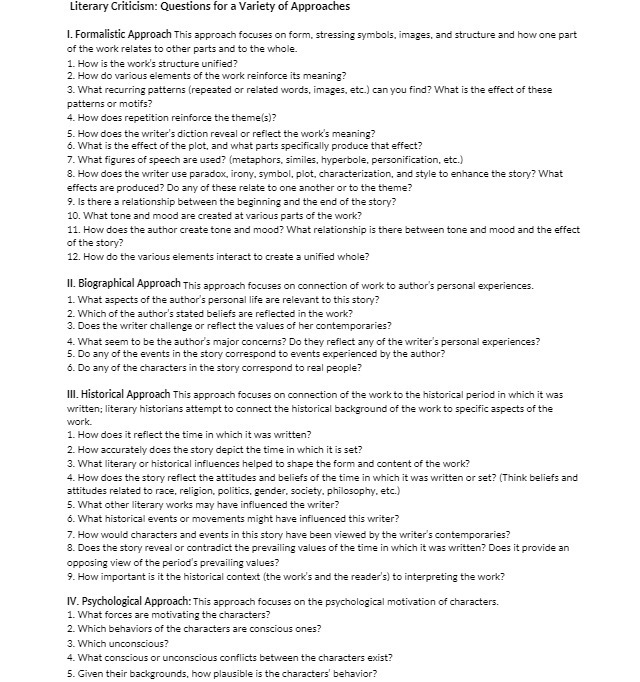Literary Criticism: Questions for a Variety of Approaches I. Formalistic Approach This approach focuses on form, stressing symbols, images, and structure and how one part of the work relates to other parts and to the whole. 1. How is the work's structure unified? 2. How do various elements of the work reinforce its meaning? 3. What recurring patterns (repeated or related words, images, etc.) can you find? What is the effect of these patterns or motifs? 4. How does repetition reinforce the theme(s)? 5. How does the writer's diction reveal or reflect the work's meaning? 6. What is the effect of the plot, and what parts specifically produce that effect? 7. What figures of speech are used? (metaphors, similes, hyperbole, personification, etc.) 8. How does the writer use paradox, irony. symbol, plot, characterization, and style to enhance the story? What effects are produced? Do any of these relate to one another or to the theme? 9. Is there a relationship between the beginning and the end of the story? 10. What tone and mood are created at various parts of the work? 11. How does the author create tone and mood? What relationship is there between tone and mood and the effect of the story? 12. How do the various elements interact to create a unified whole? Il. Biographical Approach This approach focuses on connection of work to author's personal experiences. 1. What aspects of the author's personal life are relevant to this story? 2. Which of the author's stated beliefs are reflected in the work? 3. Does the writer challenge or reflect the values of her contemporaries? 4. What seem to be the author's major concerns? Do they reflect any of the writer's personal experiences? 5. Do any of the events in the story correspond to events experienced by the author? 6. Do any of the characters in the story correspond to real people? Ill. Historical Approach This approach focuses on connection of the work to the historical period in which it was written; literary historians attempt to connect the historical background of the work to specific aspects of the work. 1. How does it reflect the time in which it was written? 2. How accurately does the story depict the time in which it is set? 3. What literary or historical influences helped to shape the form and content of the work? 4. How does the story reflect the attitudes and beliefs of the time in which it was written or set? (Think beliefs and attitudes related to race, religion, politics, gender, society. philosophy, etc.] 5. What other literary works may have influenced the writer? 6. What historical events or movements might have influenced this writer? 7. How would characters and events in this story have been viewed by the writer's contemporaries? B. Does the story reveal or contradict the prevailing values of the time in which it was written? Does it provide an opposing view of the period's prevailing values? 9. How important is it the historical context (the work's and the reader's) to interpreting the work? IV. Psychological Approach: This approach focuses on the psychological motivation of characters. 1. What forces are motivating the characters? 2. Which behaviors of the characters are conscious ones? 3. Which unconscious? 4. What conscious or unconscious conflicts between the characters exist? 5. Given their backgrounds, how plausible is the characters' behavior







